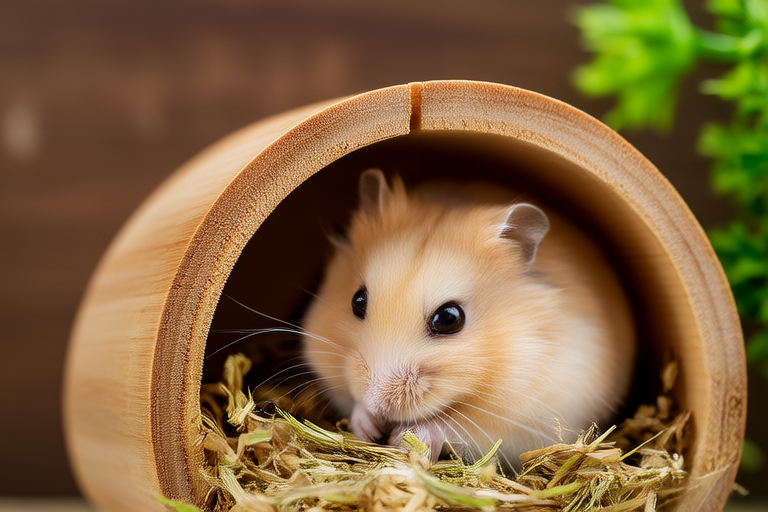How to Create the Ultimate Hideout for Your Happy Hamster
Welcome to the world of hamster ownership! Creating the perfect hideout for your furry friend is an essential step in ensuring their happiness and well-being. Whether you’re a novice or an experienced hamster owner, this guide will walk you through the process of building the ultimate hideout that keeps your hamster cozy, entertained, and healthy.
Selecting the Right Type of Hideout
The first step in creating the perfect hideout is choosing the right type of hideout for your hamster. There are various options available, each with its own benefits. A simple cardboard box can be a great choice as it’s easy to replace and inexpensive. Alternatively, you can opt for a ceramic or wooden house, which offers durability and a more natural look. It’s important to choose a hideout that matches your hamster’s size and personality.
If your hamster enjoys burrowing, consider adding a tunnel system or a nest box to their hideout. These additions provide extra comfort and allow your hamster to explore and play. For hamsters that enjoy climbing, a multi-level hideout with platforms and ramps can offer hours of entertainment. Regardless of the type of hideout you choose, ensure it has an entrance that’s big enough for your hamster to enter and exit comfortably.
Ensuring Proper Size and Ventilation
When selecting a hideout for your hamster, it’s crucial to consider its size and ventilation. The hideout should be spacious enough for your hamster to move around freely but not so large that it feels empty. A good rule of thumb is to ensure the hideout is at least twice the length of your hamster when stretched out. This allows them ample room to move and stretch their legs.
Ventilation is equally important to prevent the hideout from becoming stuffy and uncomfortable for your hamster. Make sure the hideout has small holes or slits that allow fresh air to circulate. If you’re building a custom hideout, consider adding mesh panels to the sides or top for better airflow. Proper ventilation helps maintain a comfortable temperature and reduces the risk of respiratory issues.
Adding Cozy Bedding Materials
Providing a comfortable and cozy bed is essential for your hamster’s well-being. Choose bedding materials that are soft, absorbent, and safe for your hamster to chew on. Popular choices include shredded paper, wood shavings, and cotton wool. Avoid using materials that could cause health problems, such as cedar or pine shavings, as they contain oils that can irritate your hamster’s respiratory system.
Fill the bottom of the hideout with about two inches of bedding material to create a soft and comfortable sleeping area. You can also add a small towel or blanket for extra warmth and comfort. Ensure the bedding is clean and free from contaminants, and change it regularly to maintain hygiene. Providing a variety of textures and materials can help stimulate your hamster’s senses and keep them engaged.
Incorporating Safe Toys and Tunnels
To keep your hamster mentally and physically stimulated, incorporate safe toys and tunnels into their hideout. Hamsters are curious creatures that love to explore, so adding tunnels and bridges can encourage them to move around and play. You can use items like PVC pipes, cardboard tubes, or even rolled-up towels to create tunnels. Just make sure they’re sturdy and safe for your hamster to crawl through.
In addition to tunnels, consider adding toys that promote chewing and gnawing. Hamsters have continuously growing teeth, so providing them with appropriate items to chew on is vital for their dental health. Wooden blocks, untreated twigs, or hay balls are excellent choices. Ensure all toys are safe and non-toxic before introducing them to your hamster’s hideout.
Maintaining Hygiene
Hygiene is critical for keeping your hamster healthy and happy. Regular cleaning of the hideout is necessary to prevent the buildup of bacteria, odors, and harmful substances. Aim to clean the hideout at least once a week, or more frequently if needed. Start by removing all bedding and toys, then thoroughly clean the hideout with warm water and a mild detergent. Rinse it well and let it dry completely before replacing the bedding and toys.
It’s also important to monitor your hamster’s behavior and health regularly. Signs of illness, such as lethargy, loss of appetite, or changes in bathroom habits, should be addressed promptly. Consult a veterinarian if you notice any concerning symptoms. By maintaining a clean and hygienic environment, you can help prevent illnesses and ensure your hamster stays healthy and active.
Providing Sufficient Space for Exercise
Hamsters are highly active animals that require ample space to exercise and explore. In addition to their hideout, provide a large cage or enclosure where they can run, climb, and play. The cage should be at least three times the length of your hamster when stretched out and equipped with wheels, tunnels, and other toys. A running wheel is particularly beneficial for hamsters, as it allows them to burn off excess energy and stay fit.
Ensure the wheel is the appropriate size for your hamster to avoid injuries. A diameter of at least six inches is recommended for most hamsters. Place the wheel in a location that’s easily accessible but not too close to the hideout, as some hamsters prefer separate areas for sleeping and exercising. Rotate the wheel occasionally to prevent boredom and provide new challenges for your hamster.
